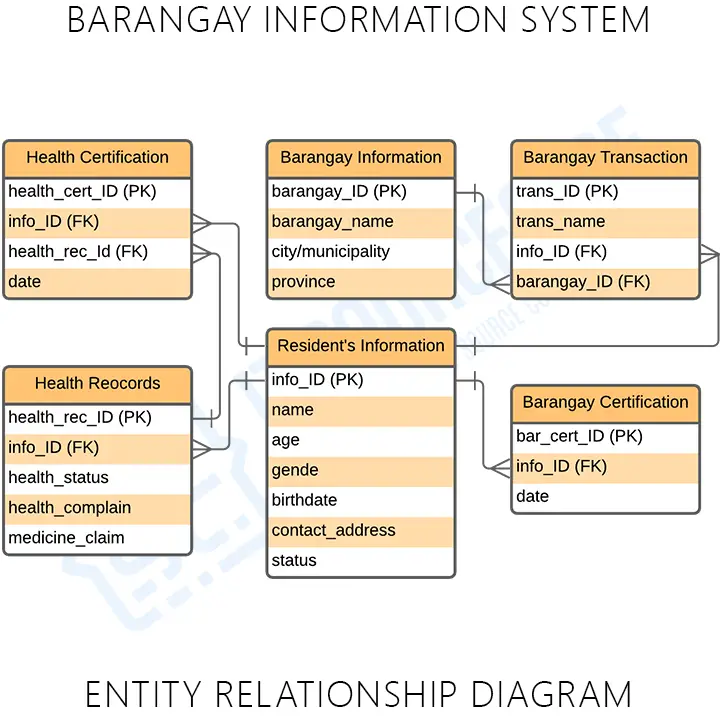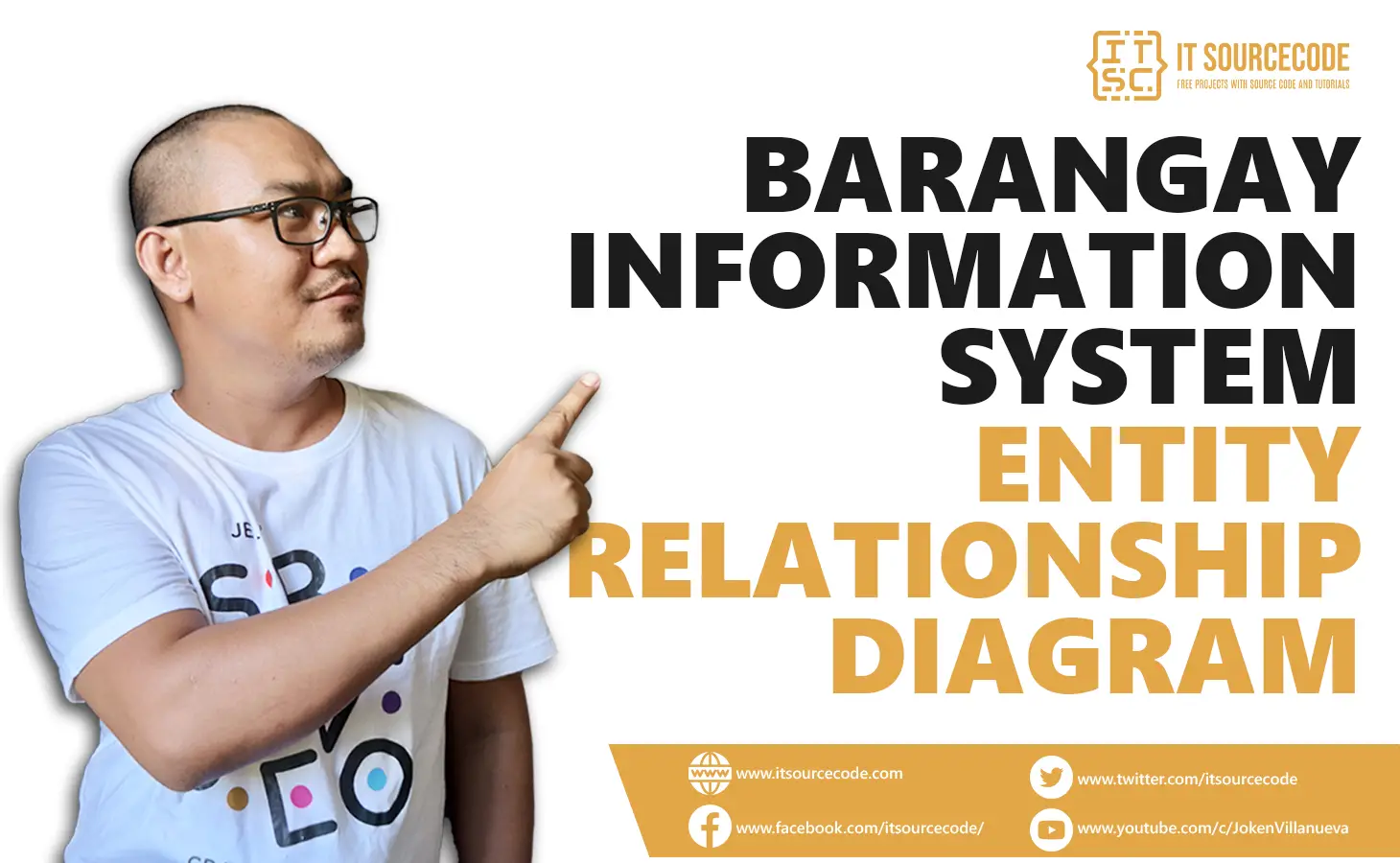The barangay information system ER diagram shows the relationships of the project entities in its database design. It describes the logical structure of the system’s database or data storage. It is done by identifying the barangay information process entities, their properties, and the interactions between them.
The barangay information system database design is sketched out using ER diagram. This database sketch becomes the actual basis of the system’s data storage that will serve as data destination and source.
Barangay Information System ER Diagram: Details
The table shows the overall description of the ER Diagram for Barangay Information System. It has a complete overview of the project’s information.
| Name: | Barangay Information System ER Diagram |
| Abstract: | The barangay information system ER diagram depicts the relationship between various entities. It can be thought of as a blueprint for your system (project) structure. |
| Diagram: | ER Diagram is also known as Entity Relationship Diagram |
| Tools Used: | Diagraming tools that provide ER diagram symbols. |
| Users: | Website, Applications, and Software. |
| Designer: | ITSourceCode.com |
What is a Barangay Information System?
The Barangay Management Information System (BMIS) makes it easier to identify barangay needs that are important for planning nutrition and development, implementing projects, monitoring their progress, and evaluation. It also helps to build the capacity of Barangay Development Councils (BDCs) for electronic governance.
It is suitable for usage by barangay employees whose direct reports have access to the profiles of barrio residents. The organizational staff within departments who require this information for their business units can also profit from it.
What is an ER Diagram?
The ER Diagram is referred to as the database design for barangay information system. This is the graphical depiction of relationships between all the entities involved in the system. Its major components are Entities, Attributes, and Relationships.
In DBMS, the barangay information system ER Diagram is used to build and troubleshoot relational databases. It works best with DFD (Data Flow Diagram), which is responsible for data movement. Creating the barangay information system database design would be much easier with the help of ER diagram.
The barangay information system ER diagram aims to answer the barangay information database design. The system’s function is to encode customer information and transaction. Also, the barangay information admin must have access to the customer information for reports and inventory purposes. The data used in these transactions must be managed and secured well and the use of ER Diagram for Barangay Information System is needed.
Barangay Information System Features
- Barangay Information Management – This means that the system can handle and secure the barangay transactions including the residents’ information.
- Residents’ Information Management – This feature plays a big role in the system because this gathers important information about the barangay residents. This information was used for determining the transactions made by certain barangay residents.
- Manage Barangay Transaction – This system stores the transactions that were made in the barangay, These transactions are essential for handling barangay information because this transaction includes releasing of barangay certificates and other proof of residency in the barangay.
- Transaction and Reports Management – This feature will store the transactions made including their information and the reports of every transaction in the corresponding timetables.
ER Diagram for Barangay Information System
ER Diagram of Barangay Information System shows the system entity relationships in each entity and their supposed functions in each relationship.

The ER diagram for barangay information system tables includes; health certification, health records, Resident’s Information, barangay certification, barangay information, and barangay certification.
The tables are made to meet the required specification of the system and provide much more specific details of each entity within the system.
Barangay Information System Database Design
The barangay information system database design was made based on barangay information system requirements. The system can encode the residents’ information upon their residency. The admin can have access to the residents’ status as well as their transactions. They can handle the data needed in managing information and records the request made by the residents.
The features included in the system ER diagram were the security and monitoring of the barangay information status. These features were also listed and recorded in reports that served as the history of transactions done in the system.
Barangay Information System ER Diagram Tables
These tables below provide the complete database table details such as Field Name, Descriptions, data types, and character lengths.
Table Name: Resident’s Information
| Field | Description | Type | Length |
| info_ID (PK) | Information ID | Int | 11 |
| name | Residents’ Name | Varchar | 255 |
| age | Residents’ Age | Int | 11 |
| gender | Residents’ Gender | Varchar | 255 |
| birthdate | Residents’ Birthdate | Date | |
| contact_address | Residents’ Contact Address | Int | 11 |
| status | Residents’ Status | Varchar | 255 |
Table Name: Barangay Information
| Field | Description | Type | barangay |
| barangay_ID (PK) | Barangay ID | Int | 11 |
| barangay_name | Barangay Name | Varchar | 255 |
| city/municipality | City/Municipality | Varchar | 255 |
| province | Province | Varchar | 255 |
Table Name: Barangay Transaction
| Field | Description | Type | Length |
| trans_ID (PK) | Transaction ID | Int | 11 |
| trans_name | Transaction Name | Varchar | 30 |
| info_ID (FK) | Last Name | Varchar | 30 |
| barangay_ID (FK) | Address | Text |
Table Name: Barangay Certification
| Field | Description | Type | Length |
| bar_cert_ID (PK) | Barangay Certification ID | Int | 11 |
| info_ID (FK) | Information ID | Int | 11 |
| date | Date of Certification | Date |
Table Name: Health Certification
| Field | Description | Type | Length |
| health_cert_ID (PK) | Health Certification ID | Int | 11 |
| info_ID (FK) | Information ID | Int | 11 |
| health_rec_ID | Health Record ID | Int | 11 |
| date | Information ID | Time |
Table Name: Health Records
| Field | Description | Type | Length |
| health_rec_ID (PK) | Health Record ID | Int | 11 |
| info_ID (FK) | Information ID | Int | 11 |
| health_status | Health Status | Varchar | 255 |
| health_complain | Health Complain | Varchar | 255 |
| medicine_claim | Transaction Date | Varchar | 255 |
The tables given will be the basis for developers on how would they create the barangay information system database design. It has the complete description of the database and they will put this into the program or data storage the same as the names given to each of the tables. They will create a database with the attributes given as well as the value of each attribute.
Barangay Information System ERD [PDF]
The ER diagram for barangay information system PDF provides the information explaining the concepts of the project database. You may apply this information to your capstone project. You can also use it directly or modify its content depending on your project’s requirements.
How to create ER Diagram
Time needed: 5 minutes
Steps in building the ER Diagram for Barangay Information System with Cardinality Ratio.
- Step 1: Familiarize the ER Diagram (Entity Relationship Diagram) Symbols and Cardinality
Entity Relationship Diagram – shows the structure of data types in a project. It uses symbols to clarify its parts and relationships. Their symbols and applications must be familiarized before you build the ER Diagram.
ER Diagram Symbols:
• Fields: Fields are the parts of a table that define the entity’s characteristics. In the database that the ERD models, attributes are commonly thought of as rows.
• Keys is a technique to categorize data qualities. It is used to organize ER diagrams and assist users in modeling their databases to ensure that they are efficient. This is also used to connect different tables in a database.
– Primary Key: identifies a single entity instance which means a unique attribute or set of attributes.
– Foreign Key: is produced when data attributes have one too many relationships with other entities.
ER Diagram Cardinalities:
The styling of a line and its termination demonstrates cardinality and ordinality.
The greatest number of times an instance of one thing can be related to instances of another entity is referred to as cardinality.
While Ordinality refers to the fewest number of times a single entity instance can be linked to another. - Step 2: Finalize the entities included
Start designing your ER Diagram by finalizing the entities that must be included in your bank reservation system. This entity is represented by a rectangle, and you’ll want to leave plenty of room for them in future phases so you may add them to your design.
An entity set is a group of similar entities with shared properties. A table or a table’s attribute is an entity in a database reservation system. As a result, by depicting relationships between tables and their characteristics, an ER diagram displays the whole logical structure of a database. - Step 3: Add the attributes of each entity
After finalizing the entities, think about the qualities you’ll need to characterize each entity. The details of the various entities outlined in a conceptual ER diagram are supplied as attributes. Characteristics of an entity, a many-to-many relationship, or a one-to-one relationship are all examples of attributes. Multivalued attributes can be assigned to several values.
The entity’s attributes were represented by ovals and can be seen in the tables of the bank reservation system er diagram. These attributes can be a primary key or a foreign key in the database design of the project. Your ER diagram design could also be converted to the database of the system by declaring your right entities and their attributes. - Step 4: Describe the relationships (cardinality) between entities and attributes
To plot relationships between the ERD you will need the entities, their attributes, and relationships. You will base the data structure from the evaluated information to have the exact Entity Relationship Diagram.
A relationship is an association that describes how two entities interact. At the connector’s endpoints, the cardinality is indicated by a crow’s foot. One-to-one, one-to-many, and many-to-many are the three most common cardinal relationships. It’s the maximum number of times an instance of one entity can be linked to instances of another entity.
Conclusion:
You need to know the diagrams used to design and develop the Barangay Information System. That is to help you create a fully-functional Barangay Information System with ER Diagram. Creating it will help you perceive the back end of the software. This will hold all the data that’ll enter and exit the system.
Related Articles:
- Student Enrollment System ER Diagram
- Bus Reservation System ER Diagram
- ER Diagram for Online Shopping System
- ER Diagram for Online Shopping System
- Loan Management System ER Diagram
Recommended Article:
Inquiries
If you have inquiries or suggestions about the Barangay Information System ER Diagram, just leave us your comments below. We would be glad to know to concerns and suggestions and be part of your learning.

